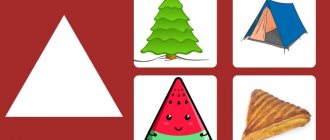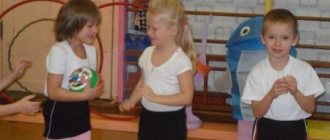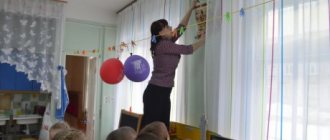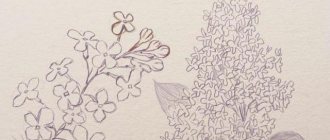Technological map - construct
| Reflection 2-3 min. | Summing up, positive assessment of the result obtained | Expresses sincere admiration. Thanks the children, receives positive feedback from the forest inhabitants. Provides opportunities for independent play. | Children are happy with the results obtained and the positive assessment of their work. They are glad that they were able to help. Participate in play activities. | The children are satisfied with the results of their activities. Express positive emotions. |
Synopsis of the educational activity “In a forest clearing”.
Educational areas:
“Cognitive development”, “Social and communicative development”, “Speech development”, “Artistic and aesthetic development”, “Physical development”.
Kind of activity:
gaming, communicative, motor.
Age group:
younger age.
Temporary resource:
15 minutes.
GCD topic:
"In a forest clearing."
Target:
formation of elementary mathematical concepts; to train children in using mathematical knowledge in a play situation; consolidate children's mathematical concepts through didactic games.
Tasks:
Educational:
— consolidate children’s knowledge about elementary sensory standards (shape, color, size);
- consolidate mathematical concepts: one-many, the same amount (equally), more-less, high-low, big-small;
- to consolidate children’s knowledge about wild animals and the rules of behavior in the forest;
-improve the ability to distinguish and name geometric shapes (circle, square, triangle, rectangle).
Educational:
—
develop attention, memory, communication skills;
-develop the ability to make proposals and draw simple conclusions, to express one’s thoughts clearly for others.
Educational:
- cultivate a sense of compassion and desire to help;
-develop communication skills with adults and peers;
- cultivate love and interest in living nature.
Facilities:
- visual:
bell;
-musical:
musical recordings of forest noise, birdsong;
-materials, equipment:
easel (magnetic board), CD player, set of large geometric shapes, images of hedgehogs and Christmas trees (3 pieces, different in size), a set of numbers from 1 to 5, educational games “Butterflies and Flowers”, “Hide the Mouse”.
Planned result:
they can recognize and name elementary sensory standards (color, shape, size), they can compare using the application method, they can arrange objects by height and size (up to 3 objects) and name them accordingly, they can count to 5 or more.
Attitude to activity:
interest, emotionality, children willingly engage in playful interactions with adults and peers.
Preliminary work:
acquaintance with sensory standards (color, shape, size), viewing pictures of the forest at different times of the year, conversations about the rules of behavior in the forest, about forest inhabitants, didactic games “Moms and their children”, “What color”, “Pick a pair”, “What is round (square, triangular”, “Correspondences”, designing, drawing and applique “House”, listening to musical pieces on the theme “Forest”.
GCD construct “Travel with the Hedgehog to the Magic Forest”
author: Kryukova Olga Vladimirovna
Teacher at the Children's Educational Institution "Kindergarten No. 15" in Krasnoturinsk
GCD construct “Travel with the Hedgehog to the Magic Forest”
Municipal autonomous preschool educational institution "Kindergarten No. 15"
Construct of continuous educational activities
with children of the fourth year of life
(educational areas “Cognitive development”, “Speech development”)
"Travel with the Hedgehog to the Magic Forest"
Educator: Olga Vladimirovna Kryukova
GO Krasnoturinsk
2019
Subject
: “A trip with the Hedgehog to the magical forest.”
Age group:
children of the fourth year of life.
GCD form:
cognitive-research, communicative.
Form of organization
(group).
Educational and methodological kit
: Babaeva T.I., Gogoberidze A.G., Solntseva O.V. Childhood: Sample educational program for preschool education.
Facilities:
Gaming
toy Hedgehog, playing field “Mini-Large”, set “Multi-colored ropes”, “Multi-colored gnomes”, logic blocks of Dienesh, planar geometric shapes.
Visual
a picture depicting the articulation exercise “Smile”, symbol cards with block properties.
Literary
riddle about a hedgehog.
Equipment:
rubber mats, rope.
Target:
the formation of cognitive motivation and the formation of cognitive actions, maintaining the child’s initiative and independence in verbal communication with adults and peers.
| Objectives of the educational program |
| Educational: — develop the articulatory apparatus, consolidate the correct pronunciation of the isolated sound [f]; - develop the ability to group geometric shapes by color, size and shape; Educational: - learn to understand the questions posed by the teacher and answer them at the request of an adult; - learn to select definition words for the word “hedgehog”; Educational: — Developing communication skills, interaction, and a sense of goodwill. |
| Stages (sequence) of activity | Contents of activities (methods and techniques) | Actions, activities of the teacher | Actions, activities of children, implementation, which will lead to the achievement of planned results | Planned result |
| Motivation for joint activities | - Guys, today a guest came to us from a magical forest, and who is it? Guess the riddle: Fur coat - needles. It will curl up - prickly. You can't take it with your hand. Who is this? (Hedgehog) - That's right, it's a hedgehog. Let's say hello and smile to him. Articulation exercise “Smile”. | Creates an atmosphere of interest. Makes a riddle. Shows a picture of the “Smile” exercise being performed. | Children guess the riddle. Perform an articulation exercise (in chorus and individually) | Readiness of children to communicate with adults in joint activities |
| Updating knowledge | - What hedgehog? (Prickly, gray, small, hardworking) - What is the hedgehog doing? (Gets food, hunts mice) — Now let’s play the game “What does a hedgehog look like”: Prickly hedgehog, what? (like a Christmas tree) Gray hedgehog, like who? (like a bunny, like a kitten) — Hedgehog: Right. Let's sing the hedgehogs' song. Song of an adult hedgehog: “F-F-F” small hedgehog | Asks questions that stimulate the thinking process. Plays a word game. Reminds me of a hedgehog song. | Children answer questions. Children make guesses. Children pronounce the sound [f] louder, quieter. | Shows curiosity. Shows interest in communicative activities. |
| Motivation for activity Game situation | — Hedgehog: I invite you guys to the magical forest to see my friends. — Educator: How do we get there? — Hedgehog: You need to say the magic words: “Wa-wa-wa, grass has grown in the forest.” — Hedgehog: The road to the magic forest is not easy, I will help you. You need to go over the bumps and jump over the stream. Here we are. The magical gnomes “Kohle” and “Jelly” live here. Dwarves love to play, let's play. | Emotionally involves children in action. Pronounces pure speech. Draws attention to the carpet. | Children take turns pronouncing the phrase (in chorus, individually) They are walking along a magical road. | Showing initiative in communicating with adults |
| Physical school | We are funny gnomes In our home, we sing songs! (hands on the belt, bending to the sides) We love to run like mice. (running in place) We are funny gnomes In our home, we sing songs! (alternately put out the right and left legs) We love to stomp like elephants. (stomp on the spot) We are funny gnomes In our home, we sing songs! (spinning) We love to jump like bunnies! (jumping in place) | Emotionally involves children in action. | Motor activity of children. | The desire for physical activity. |
| Updating children's knowledge | — Hedgehog: I prepared gifts for the gnomes, but a mischievous wind blew and mixed up all the gifts. Guys, can you help me sort out the gifts? (There are blocks and symbol cards on the table) — On the table in front of you are 2 cards, pieces of paper with hoops drawn on them. You and I will, in accordance with the card symbol, distribute the blocks into hoops. For example, on a card there is a geometric figure drawn, a square and the color red, which means that all the red squares must be placed in this hoop. On another card there is a circle drawn and the color is yellow, which means that all yellow circles must be placed in this hoop. — Yesenia and Nikita will lay out the figures on the carpet. Other children lay them out on the tables. — Why are these particular blocks in this hoop? — Hedgehog: Thank you guys for helping me. — Educator: It's time for us to go back to kindergarten. Goodbye hedgehog! We are walking along the magic path. | Creates an atmosphere of interest. Organizes children. Draws attention to the carpet. Explains. Observes children while performing tasks. | Emotionally involved in the action. The children sit at the tables. The children are listening. (Individual work : two children perform a task on a carpet machine). Children sort by shape, color, size. Children return to kindergarten along a magical path. | Showing initiative in communicating with adults. Demonstrates the ability to generalize a group of objects by properties. |
| 3. Final part. Reflection Motivation for further knowledge | - Guys, please tell me where we went today? — What did you like most? —Who were you able to help? - Guys, do you want to know who else lives in the magical forest? | Asks questions that stimulate generalization of the results of children's activities. Initiates the children's mood for new knowledge. | Children convey their impressions about the process and results of joint activities. | Demonstrate the ability to analyze their activities. |
GCD construct “Travel with the Hedgehog to the Magic Forest”
MAGAZINE Preschooler.RF
Educator: The crews are asked to choose a captain.Now the crews have to prepare for the flight and collect the necessary things.
A game based on the educational structure TEAMBUILDING (Singapore technologies) On an A4 sheet of paper there is a triangle at the top, to the left of the triangle the number 1 is written, to the right is the number 2, in the triangle at the top is the word ALL. First, everyone works independently on a separate piece of paper and sketches 2 items that he considers necessary for space travel. Then voting takes place. The participant names the object he drew, and the rest of the team votes for or against. The results are recorded on the sheet. If all other team members are against, the item is drawn by the commander under the number 1; if more than one voted for, but not all, then under the number 2; if everyone is in favor, then the item is drawn in a triangle under the word ALL.
The result is a set of items that everyone has voted for. The crew must voice them and count the number.
Educator: Each crew determined what they would take with them on the flight, and now answer, what will you use to go into space?
Children's answers.
Educator: Each crew needs to build their own rocket.
Crews create their own space rocket on an easel from 19 geometric shapes on magnets (triangles and squares)
Educator: Guys, what geometric shapes did you use?
Children's answers.
Educator: How many triangles? - 10; How many squares? - 9; How many geometric shapes are there in total? - 19
Educator: To launch a rocket, lay out a number line from 1 to 19. We count directly from 1 to 19. Start! (recording of rocket takeoff)
Educator: The space journey has begun! The crews need to determine the course.
Each crew goes to a specific constellation, but which one you will see when you post it on your “monitor”. The crews name the constellations.
Educator: How many large stars do your constellations have? – 9. How many small stars? – 10. How many stars are there in total? - 19.
Cosmic physical exercise.
(Space tourists go into outer space)
Our space journey continues, its program includes travelers going into outer space. (To the music of the song “The Earth is visible through the porthole,” children perform various movements in “zero gravity”)
Educator: Our space travelers are hungry, I draw your attention to the fact that on board each spaceship there is a vending machine with space lunch (slide with space food). Think about what you can buy if each crew only has 9 coins.
Your ships ended up near the planets of our solar system, to find out their names you must solve examples, match the answers with letters and read the name of the planet (children are given forms with examples and letters)
GCD construct “Journey to vowel sounds”
Greeting "Sunshine":“We will raise our hands up, we will take a ray of sunshine, we will press it to our chests and send it to the guests.”
Phonopedic exercise “In Spring”
(slide No. 3)
A short conversation with children about the awakening of nature in the spring (plants, animals, including insects).
“Nature is filled with various sounds...”
The appearance of the “centipede caterpillar” (the role of an adult), which brings in an envelope “The Tale of Vowel Sounds” (slide No. 4)
Conversation with children about the sounds of speech, reading a short poem: There are many sounds in the world: the rustling of leaves, the splashing of waves, And there are sounds of speech. We need to know them for sure!
Breathing exercises “Singing vowel sounds”
(slides No. 5 - 8).
Stretching sounds on one exhalation, starting from 2 ([A - U]; [A-U-O]; [A-U-O-I]
! To speak beautifully, you need to be able to inhale and exhale correctly.
Speech motor game
""The centipede walked along a dry path..."
(slide No. 9)
Game exercise "The rain began to pound on the branches." (Self-facial massage
)
(slide No. 10)
Examination of the model
(like a garland) “Centipede”, reading the poem “The barefoot centipede had pain in its legs...” (the model is used throughout the “journey”: after completing the exercises, the children decorate it with a “portrait” of the vowel sound).
Game exercise “Wonderful bag”
Modified game
“Centipede” (with a massage ball).
Children pass the ball to each other, standing in a circle (light palm massage).
Second option: pass the ball to each other from below or above their heads.
Completing game tasks
:
“Place the pictures along the paths to the house” (one subgroup);
“Draw paths to the houses (symbols) of vowel sounds (work at the easel in pairs).
Completion of tasks is checked (slide No. 11, 12)
Exercise “The fourth odd one” (slide No. 13,14)
Four tracks, each with four pictures, the images in three pictures begin with the same vowel sound.
Imitation-catch-up “Centipede”
“Find vowels in a clearing among flowers” (slide No. 17)
The vowels are “hidden” among the flowers.
Finger gymnastics
"Two centipedes were running along the path."
Slide number 19
Slide No. 20 (test)
Each child has a sheet with a picture of a “centipede”
and a set of vowel sound symbols (“portraits”).
It is necessary to determine the first vowel sound in a word and correlate it with a symbolic designation.
Breathing exercise
“Find the letter “among the bumps.”
"Fold the letter"
The adult character “Centipede” tells the children that she has prepared a gift for them - a funny picture; on the way to visit, the picture accidentally fell and crumbled. But can it be quickly put in order? How?
Working on the interactive whiteboard
(compiling a picture from separate drawings-fragments: fisherman with
his
daughter,
ley
,
oh
zero
, and
wa,
oh
dot,
oh
sy,
oh
cloud)
Compiling a House of Vowel Sounds.
Search for “Sound” gifts (symbols of consonant sounds).
Exercise "Sunshine".
“And now we’ll quietly approach the Centipede...
Carefully, carefully, we will take it in our hands and take it to our group” ( model of the alphabet created during the exercises).




